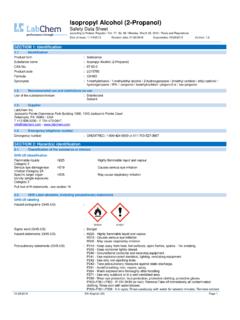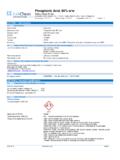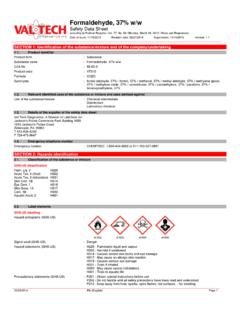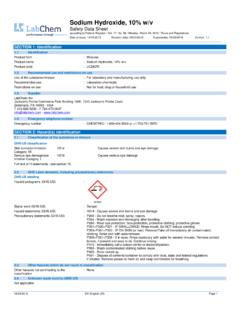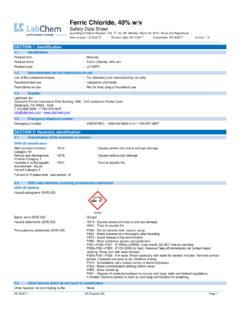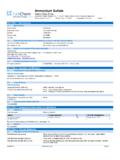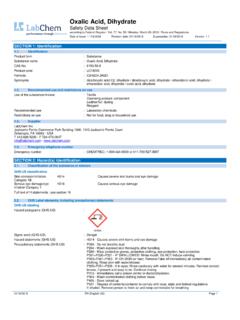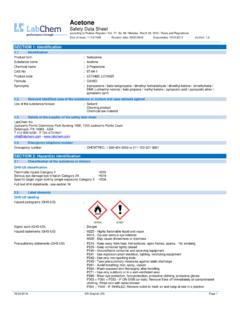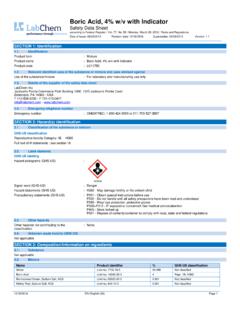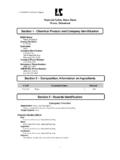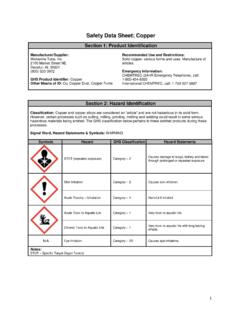Transcription of EDTA, Disodium, Dihydrate
1 EDTA, disodium , Dihydrate Safety Data Sheet according to Federal Register / Vol. 77, No. 58 / Monday, March 26, 2012 / Rules and Regulations date of issue: 10/29/2004 Revision date : 03/23/2017 Supersedes: 09/05/2013 Version: 03/23/2017 EN (English US) Page 1 SECTION 1: Identification Identification Product form : Substance Substance name : EDTA, disodium , Dihydrate CAS No : 6381-92-6 Product code : LC13750 Formula : C10H14N2O8Na2 2H2O Synonyms : Ethylenediaminetetraacetic acid, disodium salt, Dihydrate Relevant identified uses of the substance or mixture and uses advised against Use of the substance/mixture : For laboratory and manufacturing use only. Recommended use : Laboratory chemicals Restrictions on use : Not for food, drug or household use Details of the supplier of the safety data sheet LabChem Inc Jackson's Pointe Commerce Park Building 1000, 1010 Jackson's Pointe Court Zelienople, PA 16063 - USA T 412-826-5230 - F 724-473-0647 - Emergency telephone number Emergency number : CHEMTREC: 1-800-424-9300 or 011-703-527-3887 SECTION 2: Hazard(s) identification Classification of the substance or mixture GHS-US classification Acute toxicity (oral) Category 4 H302 Skin corrosion/irritation Category 2 H315 Serious eye damage/eye irritation Category 2A H319 Specific target organ toxicity (single exposure) Category 3 H335 Full text of H statements : see section 16 Label elements GHS-US labeling Hazard pictograms (GHS-US) : GHS07 Signal word (GHS-US) : Warning Hazard statements (GHS-US).
2 H302 - Harmful if swallowed H315 - Causes skin irritation H319 - Causes serious eye irritation H335 - May cause respiratory irritation Precautionary statements (GHS-US) : P261 - Avoid breathing dust P264 - Wash exposed skin thoroughly after handling P270 - Do not eat, drink or smoke when using this product P271 - Use only outdoors or in a well-ventilated area P280 - Wear eye protection , protective gloves P301+P330+P331 - IF SWALLOWED: rinse mouth. Do NOT induce vomiting P302+P352 - IF ON SKIN: Wash with plenty of soap and water P311 - Call a POISON CENTER or doctor/physician P305+P351+P338 - If in eyes: Rinse cautiously with water for several minutes. Remove contact lenses, if present and easy to do. Continue rinsing P332+P313 - If skin irritation occurs: Get medical advice/attention P337+P313 - If eye irritation persists: Get medical advice/attention P362 - Take off contaminated clothing and wash it before reuse P403+P233 - Store in a well-ventilated place.
3 Keep container tightly closed EDTA, disodium , Dihydrate Safety Data Sheet according to Federal Register / Vol. 77, No. 58 / Monday, March 26, 2012 / Rules and Regulations 03/23/2017 EN (English US) 2/6 P405 - Store locked up P501 - Dispose of contents/container to comply with local, state and federal regulations If inhaled: Remove person to fresh air and keep comfortable for breathing Other hazards Other hazards not contributing to the classification : None. Unknown acute toxicity (GHS US) Not applicable SECTION 3: Composition/Information on ingredients Substances Substance type : Mono-constituent Name Product identifier % GHS-US classification EDTA, disodium , Dihydrate (Main constituent) (CAS No) 6381-92-6 100 Acute Tox. 4 (Oral), H302 Skin Irrit. 2, H315 Eye Irrit. 2A, H319 STOT SE 3, H335 Full text of hazard classes and H-statements : see section 16 Mixtures Not applicable SECTION 4: First aid measures Description of first aid measures First-aid measures general : Never give anything by mouth to an unconscious person.
4 If you feel unwell, seek medical advice (show the label where possible). First-aid measures after inhalation : Remove victim to fresh air and keep at rest in a position comfortable for breathing. Call a POISON CENTER or doctor/physician if you feel unwell. First-aid measures after skin contact : Wash with plenty of soap and water. Wash contaminated clothing before reuse. If skin irritation occurs: Get medical advice/attention. First-aid measures after eye contact : Rinse cautiously with water for several minutes. Remove contact lenses, if present and easy to do. Continue rinsing. If eye irritation persists: Get medical advice/attention. First-aid measures after ingestion : Rinse mouth. Do NOT induce vomiting. Obtain emergency medical attention. Call a POISON CENTER or doctor/physician if you feel unwell. Most important symptoms and effects, both acute and delayed Symptoms/injuries after inhalation : May cause respiratory irritation.
5 Symptoms/injuries after skin contact : Causes skin irritation. Symptoms/injuries after eye contact : Causes serious eye irritation. Symptoms/injuries after ingestion : Swallowing a small quantity of this material will result in serious health hazard. Indication of any immediate medical attention and special treatment needed No additional information available SECTION 5: Firefighting measures Extinguishing media Suitable extinguishing media : Foam. Dry powder. Carbon dioxide. Water spray. Sand. Unsuitable extinguishing media : Do not use a heavy water stream. Special hazards arising from the substance or mixture No additional information available Advice for firefighters Firefighting instructions : Use water spray or fog for cooling exposed containers. Exercise caution when fighting any chemical fire. Prevent fire-fighting water from entering environment. protection during firefighting : Do not enter fire area without proper protective equipment, including respiratory protection .
6 SECTION 6: Accidental release measures Personal precautions, protective equipment and emergency procedures For non-emergency personnel Protective equipment : Gloves. Safety glasses. EDTA, disodium , Dihydrate Safety Data Sheet according to Federal Register / Vol. 77, No. 58 / Monday, March 26, 2012 / Rules and Regulations 03/23/2017 EN (English US) 3/6 Emergency procedures : Evacuate unnecessary personnel. For emergency responders Protective equipment : Equip cleanup crew with proper protection . Emergency procedures : Ventilate area. environmental precautions Prevent entry to sewers and public waters. Notify authorities if liquid enters sewers or public waters. Methods and material for containment and cleaning up Methods for cleaning up : On land, sweep or shovel into suitable containers. Minimize generation of dust. Store away from other materials. Reference to other sections See Heading 8. Exposure controls and personal protection .
7 SECTION 7: Handling and storage Precautions for safe handling Precautions for safe handling : Wash hands and other exposed areas with mild soap and water before eating, drinking or smoking and when leaving work. Provide good ventilation in process area to prevent formation of vapor. Avoid breathing dust. Use only outdoors or in a well-ventilated area. Hygiene measures : Do not eat, drink or smoke when using this product. Wash exposed skin thoroughly after handling. Conditions for safe storage, including any incompatibilities Storage conditions : Keep container tightly closed. Incompatible products : Strong oxidizers. Incompatible materials : Sources of ignition. Generation of airborne dust. SECTION 8: Exposure controls/personal protection Control parameters No additional information available Exposure controls Appropriate engineering controls : Emergency eye wash fountains and safety showers should be available in the immediate vicinity of any potential exposure.
8 Ensure adequate ventilation. Personal protective equipment : Safety glasses. Gloves. Dust/aerosol mask. Hand protection : Wear protective gloves. Eye protection : Chemical goggles or safety glasses. Respiratory protection : Dust formation: dust mask. Other information : Do not eat, drink or smoke during use. SECTION 9: Physical and chemical properties Information on basic physical and chemical properties Physical state : Solid Appearance : Powder. Color : white Odor : Odorless Odor threshold : No data available pH : 4 - 6 5% solution at 25 C Melting point : 252 C Freezing point : No data available Boiling point : No data available EDTA, disodium , Dihydrate Safety Data Sheet according to Federal Register / Vol. 77, No. 58 / Monday, March 26, 2012 / Rules and Regulations 03/23/2017 EN (English US) 4/6 Flash point : No data available Relative evaporation rate (butyl acetate=1) : No data available Flammability (solid, gas) : Non flammable.
9 Vapor pressure : No data available Relative vapor density at 20 C : No data available Relative density : No data available Molecular mass : g/mol Solubility : Soluble in water. Water: 11 g/100ml Log Pow : No data available Auto-ignition temperature : No data available Decomposition temperature : No data available Viscosity, kinematic : No data available Viscosity, dynamic : No data available Explosion limits : No data available Explosive properties : Not applicable. Oxidizing properties : None. Other information No additional information available SECTION 10: Stability and reactivity Reactivity No additional information available Chemical stability Stable under normal conditions. Possibility of hazardous reactions Not established. Conditions to avoid Extremely high or low temperatures. Incompatible materials Strong oxidizers. Hazardous decomposition products Nitrogen oxides.
10 Carbon monoxide. Carbon dioxide. SECTION 11: Toxicological information Information on toxicological effects Likely routes of exposure : Inhalation; Skin and eye contact Acute toxicity : Oral: Harmful if swallowed. EDTA, disodium , Dihydrate (6381-92-6) LD50 oral rat 2000 mg/kg ATE US (oral) mg/kg body weight Skin corrosion/irritation : Causes skin irritation. pH: 4 - 6 5% solution at 25 C Serious eye damage/irritation : Causes serious eye irritation. pH: 4 - 6 5% solution at 25 C Respiratory or skin sensitization : Not classified Germ cell mutagenicity : Not classified Carcinogenicity : Not classified Reproductive toxicity : Not classified Specific target organ toxicity single exposure : May cause respiratory irritation. EDTA, disodium , Dihydrate Safety Data Sheet according to Federal Register / Vol. 77, No. 58 / Monday, March 26, 2012 / Rules and Regulations 03/23/2017 EN (English US) 5/6 Specific target organ toxicity repeated exposure : Not classified Aspiration hazard : Not classified Potential Adverse human health effects and symptoms : Based on available data, the classification criteria are not met.
